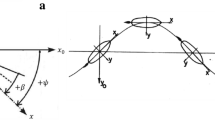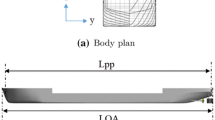Abstract
The present study aims to investigate the hydrodynamic effect of the condition of the tank bottom, e.g., false bottom vs true bottom, on the KCS container ship under static drift and static rudder configurations in shallow water (depth-draught ratio H/T = 1.2) using viscous CFD simulation with rigorous validations. The results of the grid sensitivity study for static drift in shallow water with a false/true bottom show that the grid convergence for forces, moment, sinkage, and trim are rather difficult to achieve in the solutions with the true bottom. Among the static drift cases, the computational results of forces, moment, sinkage, and trim generally show good agreement with the experimental data, provided that identical bottom configuration between the experiment and the simulation is set. Parametric study for the effect of gap size between the side wall of the towing tank and the side edge of the false bottom quantifies that the gap size of 10% ship length is still not narrow enough to approximate lateral force and yaw moment of the KCS as if it were in true bottom condition using false bottom. On the tank bottom, negative pressure magnitude and its region become larger and wider, respectively, for the true bottom than those of the false bottom at non-zero drift angle. This yields a difference in the wave profile along the hull at the suction side which results in the increase of lateral force and yaw moment with true bottom compared to those with a false bottom. The vortical structure developed between the hull and the tank bed is also affected by the difference in pressure magnitude and its distribution on the tank bed. Among the static rudder cases, the difference in pressure distribution is quite localized in the stern vicinity at the port and starboard of the hull. Yet it yields 7–10% difference in hull-rudder interaction coefficients with true bottom compared to those with false bottom although the blockage effect to the tank width is less apparent than the static drift configuration. In consequence, the shallow water effects are more pronounced using true bottom than false bottom at static drift and static rudder conditions. The present study indicates the importance of replicating the tank bottom condition in the CFD simulation similar to the experiment.



















Similar content being viewed by others
Data availability
The datasets generated during and/or analysed during the current study are available from the corresponding author on reasonable request.
References
Crane CL (1979) Maneuvering trials of a 278000-DWT tanker in shallow and deep water. SNAME Transactions 87:251–283
International Towing Tank Conference Maneuvering Committee (2008) Final report and recommendations to the 25th ITTC. In: Proceedings of 25th International Towing Tank Conference, Fukuoka, Japan
Stern F, Agdrup K, Kim SY, Hochbaum AC, Rhee KP, Quadvlieg F, Perdon P, Hino T, Broglia R, Gorski J (2011) Experience from SIMMAN2008- The first workshop on verification and validation of ship maneuvering simulation methods. J Ship Res 55(2):135–147
Yoshimura Y (1986) Mathematical model for manoeuvring ship motion in shallow water. J Kansai Soc Naval Architects Japan, 200: 41–51 (in-Japanese)
Yeo DJ, Yun K and Kim Y (2016) Experimental study on the manoeuvrability of KVLCC2 in shallow water. In: Proceeding of the 4th MASHCON, Hamburg, Germany. https://doi.org/10.18451/978-3-939230-38-0_32
ITTC Quality System Manual Recommended Procedure and Guidelines (2017) Captive model test. In: ITTC-Recommended Procedures and Guidelines, 7.5–02–06–02, Revision05
International Towing Tank Conference Maneuvering Committee (2021) Final report and recommendations to the 29th ITTC. In: Proceedings of 29th International Towing Tank Conference, on-line virtual
Böttner CU, Anschau P, Shevchuk I (2020) Analysis of the flow conditions between the bottom of the ship and of the waterway. Ocean Eng 199:107012
Dand IW, Hood DB (1983) Manoeuvring experiments using two geosims of the ‘Esso Osaka’. NMI Report R163
Yoshimura Y (2009) Simple prediction model of bow squat in shallow water. J Japn Institute Navig 121: 185–190 (in-Japanese)
Mucha P (2017) On simulation-based ship maneuvering prediction in deep and shallow water. Ph.D. dissertation. University of Duisburg-Essen. https://hdl.handle.net/20.500.11970/105067
Xu H, Hinostroza MA, Wang Z and Soares CG (2020) Experimental investigation of shallow water effect on vessel steering model using system identification method. Ocean Eng 199:106940
Toda Y, Lee YS, Sadakane H (2002) Numerical investigations of hydrodynamic forces acting on a ship hull under lateral low speed motion. J Kansai Soc Navl Archit Jpn 238:77–83
Sakamoto N, Wilson RV, Stern F (2007) Reynolds averaged Navier-Stokes simulations for high-speed Wigley hull in deep and shallow water. J Ship Res 51(3):187–203
Toxopeus SL, Simonsen CD, Guilmineau E, Visonneau M, Xing T, Stern F (2013) Investigation of water depth and basin wall effects on KVLCC2 in maneuvering motion using viscous-flow calculations. J Mar Sci Technol 18:471–496
Carrica PM, Mofidi A, Eloot K, Delefortrie G (2016) Direct simulation and experimental study of zigzag maneuver of KCS in shallow water. Ocean Eng 112:117–133
Mucha P, el Mocter O, Dettmann T, Tenzer M (2018) An experimental study on the effect of confined water on resistance and propulsion of an inland waterway ship. Ocean Eng 167:11–22
Villa D, Viviani M, Gaggero S, Vantorre M, Eloot K, Delefortrie G (2019) CFD-based analyses for a slow speed maneuverability model. J Mar Sci Technol 24:871–883
Bechthold J, Kastens M (2020) Robustness and quality of squat predictions in extreme shallow water conditions based on RANS-calculations. Ocean Eng 197:106780
Terziev M, Tezdogan T, Incecik A (2021) A numerical assessment of the scale effect of a ship advancing through restricted waters. Ocean Eng 229:108972
Liu H, Ma N, Gu X (2018) Uncertainty analysis of ship-bank interaction tests using planar motion mechanism in a circulating water channel. In: Proceedings of 13th International Conference on Hydrodynamics, Incheon, Korea, 311–320
Li M, Yuan Z, Delefortrie G (2019) Investigation of the false bottom effects on ship model tests. In: Proceedings of 6th International Conference on Advanced Model Measurement Technology for The Maritime Industry, Rome, Italy
Shi W, Li M, Yuan Z (2020) Investigation of ship-seabed interaction with a high-fidelity CFD approach. J Marine Sci Technol. https://doi.org/10.1007/s00773-020-00786-7/
SIMMAN 2020 Workshop on Verification and Validation of Ship Manoeuvring Simulation Methods, http://www.simman2019.kr/ (Accessed on May 26th, 2021)
Ohashi K, Hino T, Kobayashi H, Onodera N, Sakamoto N (2019) Development of a structured overset Navier-Stokes solver with a moving grid and full multigrid method. J Mar Sci Technol 24(3):884–901
Kobayashi H, Kodama Y (2016) Developing spline based overset grid assembling approach and application to unsteady flow around a moving body. J Math Syst Sci 6:339–347
Rumsey CL, Gatski TB (2001) Recent turbulence model advances applied to multielement airfoil computations. J Aircr 38(5):904–910
Hellsten A (1997) Some improvements in Menter’s k- SST turbulence model. Proc. 29th AIAA Fluid Dynamics Conference, Albuquerque, NM, USA
Carrica PM, Wilson RV, Stern F (2007) An unsteady single-phase level set method for viscous free surface flows. Int J Numer Methods Fluids 53:229–256
Moriyama F (1981) On the effect of a rudder on propulsive performance. J Soc Navl Archit Jpn 150:63–73
Anderson WK, Thomas JL, van Leer B (1986) A comparison of finite volume flux vector splitting for Euler equations. AIAA J 24(9):1453–1460
Hino T Ed. (2005) The Proceedings of CFD WORKSHOP TOKYO 2005, Part. B
Yun K, Park B, Yeo DJ (2014) Experimental study of ship squat for KCS in shallow water. J Soc Naval Archit Korea, 51:1:34–41 (in-Korean)
Yasukawa H, Yoshimura Y (2015) Introduction of MMG standard method for ship maneuvering predictions. J Mar Sci Technol 20:37–52
Gridgen® Version 15 User Manual. Pointwise, Inc.
ITTC Quality System Manual Recommended Procedure and Guidelines (2014) Practical guidelines for ship CFD application. In: ITTC-Recommended Procedures and Guidelines, 7.5–03–02–03, Revision01
Fukui Y, Yokota H, Yano H, Kondo M, Nakano T and Yoshimura Y (2016) 4-DOF mathematical model for manoeuvring simulation including roll motion. J Jpn Soc Naval Archit Ocean Eng 24: 167–179 (in-Japanese)
International Towing Tank Conference The Specialist Committee on Esso Osaka (2002) Final report and recommendations to the 23rd ITTC. In: Proceedings of 23rd International Towing Tank Conference, Venice, Italy.
Carrica PM, Castro AM, Stern F (2010) Self-propulsion computations using a speed controller and a discretized propeller with dynamic overset grids. J Mar Sci Technol 15(4):316–330
Bhushan S, Carrica P, Yang J, Stern F (2011) Scalability and validation study for large scale surface combatant computations using CFDShip-Iowa. Int J High Perform Comput Appl 25(4):466–487
Xing T, Bhushan S, Stern F (2012) Vortical and turbulent structures for KVLCC2 at drift angle 0, 12, and 30 degrees. Ocean Eng 55:23–43
Xing T, Stern F (2010) Factor of safety for Richardson extrapolation. J Fluids Eng 132:061403
Eca L, Vaz G, Hoekstra M (2010) Code verification, solution verification and validation in RANS solvers. In: Proceedings of the ASME 2010 29th International Conference on Ocean, Offshore and Arctic Engineering, Shanghai, China
Xing T, Carrica PM, Stern F (2008) Computational towing tank procedures for single run curves of resistance and propulsion. J Fluids Eng 130:101102
Toxopeus SL (2008) Deriving mathematical maneuvering models for bare ship hulls using viscous flow calculations. J Mar Sci Technol 14:30–38
Sakamoto N, Ohashi K, Araki M, Kume K, Kobayashi H (2019) Identification of KVLCC2 maneuvering parameters for a modular-type mathematical model by RaNS method with an overset approach. Ocean Eng 188:106257
International Towing Tank Conference The Manoeuvring Committee (2017) Final report and recommendations to the 28th ITTC. In: Proceedings of 28th International Towing Tank Conference, Wuxi, China.
Lataire E (2014) Experiment based mathematical modelling of ship-bank interaction. Ph.D. thesis, Ghent University, ISBN 978-90-8578-748-8
Acknowledgements
The experimental data of the KCS for static drift and a static rudder with a false bottom has been provided by the organizers of the SIMMAN2020 Workshop at the KRISO [24]. Their permission to use these data in the present study prior to the workshop is greatly appreciated. Constructive comments and suggestions from Professor Hironori Yasukawa at Hiroshima University are also appreciated to improve the manuscript.
Author information
Authors and Affiliations
Corresponding author
Additional information
Publisher's Note
Springer Nature remains neutral with regard to jurisdictional claims in published maps and institutional affiliations.
About this article
Cite this article
Sakamoto, N., Ohashi, K., Kobayashi, H. et al. Overset RaNS simulations and validations for the effect of false bottom to the KCS under static drift and static rudder in shallow water. J Mar Sci Technol 28, 248–269 (2023). https://doi.org/10.1007/s00773-023-00922-z
Received:
Accepted:
Published:
Issue Date:
DOI: https://doi.org/10.1007/s00773-023-00922-z




